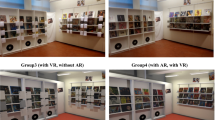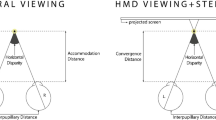Abstract
The focus of this research was to examine how effectively augmented reality displays, generated with a wearable computer, could be used for aiding an operator performing a manual assembly task. Fifteen subjects were asked to assemble a computer motherboard using four types of instructional media: paper manual, computer-aided, opaque augmented reality display, and see-through augmented reality display. The time of assembly and assembly errors were measured for each type of instructional media, and a questionnaire focusing on usability was administered to each subject at the end of each condition. The results of the experiment indicated that the augmented reality conditions were more effective instructional aids for the assembly task than either the paper instruction manual or the computer-aided instruction. The see-through augmented reality display resulted in the fastest assembly times, followed by the opaque augmented reality display, the computer-aided instruction, and the paper instructions respectively. In addition, subjects made fewer errors using the augmented reality conditions compared to the computer-aided and paper instructional media. However, while the two augmented reality conditions were a more effective instructional media when time for assembly was the response measure, there were still some important usability issues associated with the augmented reality technology that were not present in the non-augmented reality conditions.
Similar content being viewed by others
References
Ellis S, Menges B. Judgments of the distance to nearby virtual objects: interaction of viewing conditions and accommodative demand. Presence: Teleoperators and Virtual Environments 1997; 6: 452–460
Barfield W, Baird KM, Shewchuk J, Ioannou G. Applications of augmented reality and wearable computers to manufacturing. In: Barfield W, Caudell T (eds) Fundamentals of wearable computers and augmented reality. Lawrence Erlbaum Associates, in press
Azuma RT. A survey of augmented reality. Presence: teleoperators and virtual environments 1997; 6: 355–385
Barfield W, Baird KM. Future diretions in virtual reality: augmented environments through wearable computers. In: Proceedings from the 1st Annual Virtual Reality Seminar and Workshop. Kuala Lumpur, Malaysia, March 1998;
Barfield W, Baird KM. Issues in the design and use of wearable computers. Virtual Reality: Research, Development, and Applications 1998; 3: 157–166
Barfield W, Rosenberg C, Lotens W. Augmented-reality displays. In: Barfield W, Furness T (eds) Virtual environments and advanced interface design. Oxford University Press, 1995; 542–579
Janin AL, Mizell DW, Caudell TP. Calibration of head-mounted displays for augmented reality applications. In: Proceedings IEEE Virtual Reality Annual International Symposium, Seattle, WA, 18–22 Sept 1993; 246–255
Lion D, Rosenberg C, Barfield W. Overlaying three-dimensional computer graphics with stereoscopic live motion video: applications for virtual environments. SID Conference, 1993; 483–486
Starner T, Mann S, Rhodes B, Levine J, Healey J, Kirsch D, Picard R, Pentland A. Augmented reality through wearable computing. Presence: Teleoperators and Virtual Environments 1997; 6: 386–398
Holloway RL. Registration error analysis for augmented reality. Presence: Teleoperators and Virtual Environments 1997; 6: 413–432
Mizell D. Boeing's wire bundle assembly project. In: Barfield W. Caudell T. (eds) Fundamentals of wearable computers and augmented reality. Lawrence Erlbaum Associates (in press)
Ockerman J, Pritchett A. Preliminary investigation of wearable computers for task guidance in aircraft inspection. In: Proceedings of the Second International Symposium on Wearable Computers, Pittsburgh, PA, 1998; 33–40
Najjar L, Thompson J, Ockerman J. A wearable computer for quality assurance inspectors in a food processing. In: Proceedings of the First International Symposium on Wearable Computers, Boston, MA, 1997; 33–40
Siewiorek D, Smailagic A, Bass L, Siegel J, Martin R, Bennington B. Adtranz: a mobile computing system for maintenance and collaboration. In: Proceedings of the Second International Symposium on Wearable Computers, Pittsburgh, PA, 1998; 25–32
Feiner S, Webster A, McIntyre B. Wearable computers at Columbia University, 1997. http://www.cs.columbia.edu/graphics/
Author information
Authors and Affiliations
Corresponding author
Rights and permissions
About this article
Cite this article
Baird, K.M., Barfield, W. Evaluating the effectiveness of augmented reality displays for a manual assembly task. Virtual Reality 4, 250–259 (1999). https://doi.org/10.1007/BF01421808
Issue Date:
DOI: https://doi.org/10.1007/BF01421808




